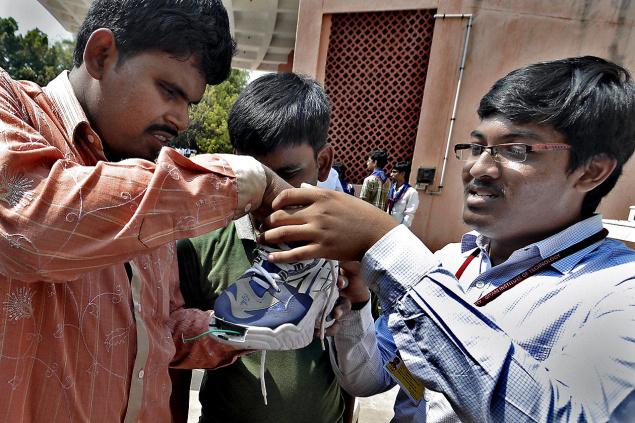
Visually challenged individuals may soon be able to enjoy a free-spirited walk without having to rely on the white stick if a young inventor’s patent for a shoe with sensors gets accepted. Krishna Sai Inkoolu, third year student of Industrial Engineering at GITAM University, has designed a shoe which has a sensor range of 2 cm to 3.5 m. The sensor detects presence of any obstacle in front of the shoe and alerts the user by giving a tap. “The sensor is placed at the weld point of the shoe, which identifies the obstacle and gives a tap on the arch of the shoe,” says Sai, who worked on the project for two years before applying for patent at Controller General of Patents Designs and Trademarks.
First of its kind
A similar concept was designed by Secunderabad-based Ducere Technologies called ‘Lechal’, a brand of interactive footwear, that uses a smartphone GPS (global positional system) app. But Sai claims that the use of micro-electronics and sensors in designing a shoe is a first of its kind.
With the help of micro-electronics, the entire circuit is placed in the shoe socket, which has a connection with the weld point where the sensor is placed. The shoe works on a rechargeable battery and in this case, there is no need to use a smartphone. But while a white stick can seldom go wrong, what if the sensor fails? How will the visually challenged individual cope in such a situation? Sai has an answer to that. “No product is 100 per cent fool proof. And in this case it is particularly critical to know if the shoe sensor has stopped working. I have embedded a mistake-proofing device in the shoe to detect any errors. If the sensor fails, it will give alarm sounds to alert the wearer,” says Sai.
The idea to design a shoe for the visually challenged first occurred to Sai during his first year engineering course while he was working on a project on a shoe that converts mechanical energy to electrical energy and has a capacity to recharge cell phones while walking. “After working on the technical part for six months, I realised that a shoe can be designed with simple modifications using the same principles,” he adds.
source: http://www.thehindu.com / The Hindu / Home> News> Cities> Visakhapatnam / Nivedita Ganguly / Visakhapatnam – March 17th, 2014